Updated March 7, 2021
“I haven’t been this excited about a social
media platform since Twitter. I’m incredibly
bullish on Clubhouse.”
—Michael Stelzner,
Founder of Social Media Examiner
If you hang out in any active marketing circles like The Copywriter Club on Facebook, you’ve probably heard of Clubhouse, the year-old audio-based social media app that allows you to connect with others in “rooms” where almost anyone can raise their hand and speak.
It’s a bit like talk radio (but a little more intimate) or maybe an audio version of Reddit, where anyone can start a conversation and almost anyone else can join in from around the world. All you need is your voice. And an iPhone. (They have plans to develop an app for Android users but for now, it’s iOS only.)
While social video has grown tremendously over the past decade—more than 500 hours of content are uploaded to YouTube every minute and thousands more to TikTok, Instagram Stories, SnapChat, Facebook Live, and other apps—voice was seemingly forgotten.
Until now.
It might be time to dust off your conference call skills and jump into Clubhouse to see what the fuss is all about.
The founders of Clubhouse say that the app is “the place for casual, drop-in audio chats.” That’s a pretty good description of our experience so far. Clubhouse enables users to open up conversations on just about any topic with people around the world, 24 hours a day.
It’s more interactive than podcasts, less stressful than video, more inclusive than a phone call, and significantly nicer than talk radio or Twitter.
And it’s addictive.
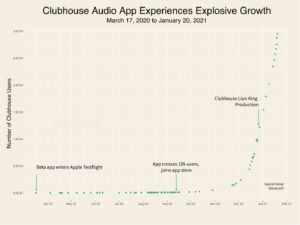
Clubhouse is quickly becoming a must-have social media app. More than a million users have downloaded the app since New Year’s Day 2021—adding to the 3.4 million total downloads since it’s launch. Some experts think Clubhouse could add 50 million more in the next few months. Investors recently valued the company at more than $1 billion.
While the developers haven’t released any usage data, according to Influencer Marketing Hub, users are spending between 11 and 22 hours on the app each week. That may be an artifact of quarantine. We suspect the actual average is a bit lower than that, but the app is addictive.
Why copywriters like you should care about Clubhouse.
As with any new technology that allows people to connect with others, Clubhouse will be used by marketers to connect with potential customers. And it will also be used for things like customer research and finding clients. Actually, it already is used for all of these things (as you’ll see below). And because it gives you the opportunity to start your own rooms and to speak in rooms started by others, it’s a great way to build your authority… or at the very least, practice sharing your thoughts and ideas in a somewhat non-threatening environment. It’s a lot easier than pitching an event (like this event for copywriters) and speaking on stage.
Even if you ultimately decide Clubhouse is not for you, as a marketer you owe it to yourself and your clients to understand the latest social media channels and how others are using it to network, connect with prospects and customers, and ultimately sell products and services—you serve your clients best by understanding the latest trends.
Given how useful Clubhouse can be for (many) copywriters, it’s time for you to jump in…
How to join Clubhouse.
Right now, Clubhouse is invite-only. Ask around, if you know a Clubhouse user, they may have an invite to share. If you don’t have your invite yet, you can download the app, sign in, then reserve your User Name. Even if you’re not interested in joining immediately, it might be a good idea to reserve your name so if you change your mind, you don’t have to show up as JimmySmith7839327 or RachelJackson474937 later.
Open up the app and complete the sign-up process. Clubhouse does not allow anonymous participants, so you’ll need to add your real name and contact information.
Finding people to follow on Clubhouse.
Click on the magnifying glass icon to search for people to follow. You can search by name, title, niche, expertise… the app will pull results from the words used in people’s bios. A search for “copywriter” will bring up hundreds of copywriters on the platform. Here are just a few of the conversion copywriters that come up for that search…
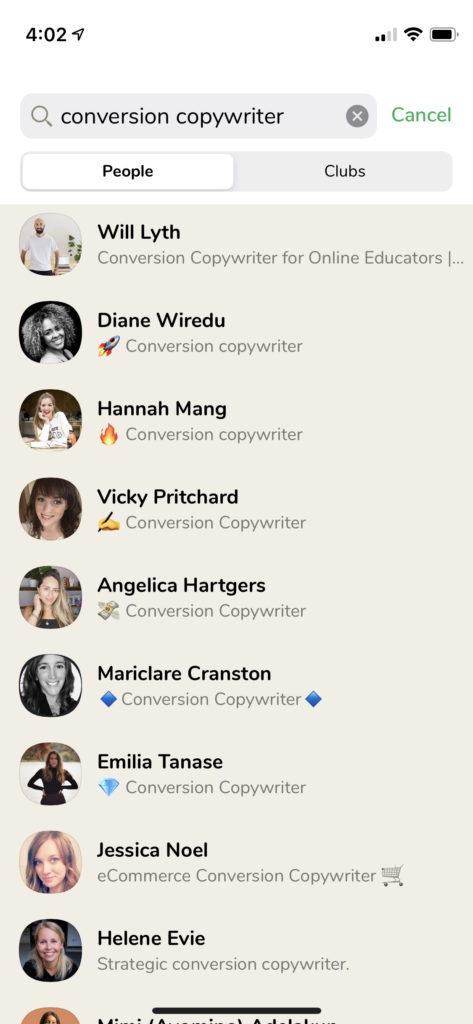 Once you’re in a room (more on this in a moment), you can click on anyone’s icon (usually their photo) to open up their profile. You can expand the profile by clicking on it (or the “view full profile” button at the bottom of the profile) to see more details.
Once you’re in a room (more on this in a moment), you can click on anyone’s icon (usually their photo) to open up their profile. You can expand the profile by clicking on it (or the “view full profile” button at the bottom of the profile) to see more details.
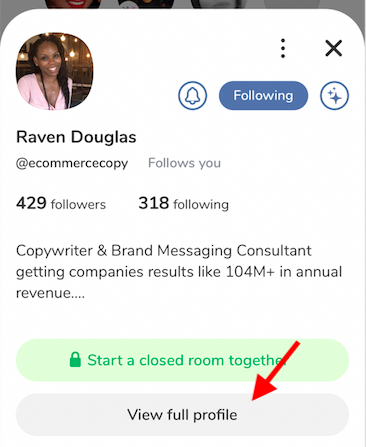
In the top right corner, you’ll see a “follow” button. Once you click that, you’ll see a bell icon to the left. If you click that, you’ll be notified (sometimes or always) when the person you are following goes live on Clubhouse.
Looking for copywriters to follow and connect with on Clubhouse? Here are a few people to get you started. Follow them on Clubhouse and you’ll start seeing the rooms they follow too:
@kirahug
@robmarsh
@christinatorres
@brittanymcbean
@laurabelgray
@rayedwards
@davidduetsch
@ecommercecopy (Raven Douglas)
@parrislampropoulos
@rhubarbcopy
@strongestcopy
@dashofcopy
@nicolamoors
@amyposner
@alygoulet
There’s a limit on the number of people you can follow— 2,500. We can’t imagine keeping up with that many contacts, but you might want to. If you bump up against the limit, you’ll have to unfollow a few people before you add more.
Once you follow someone, you can also see who they follow. Click their profile, then tap on the “following” portion of the profile. It’s not exactly a button, but it will open up a list of everyone they follow. Scan those lists for even more people worth following and learning from.
Following interests on Clubhouse.
Like following people, you can also follow interests. Clubhouse has organized topics into categories like “Entertainment,” “Faith,” “Hustle,” and “Identity.” You can find all of the interest categories using the search function (the magnifying glass icon).
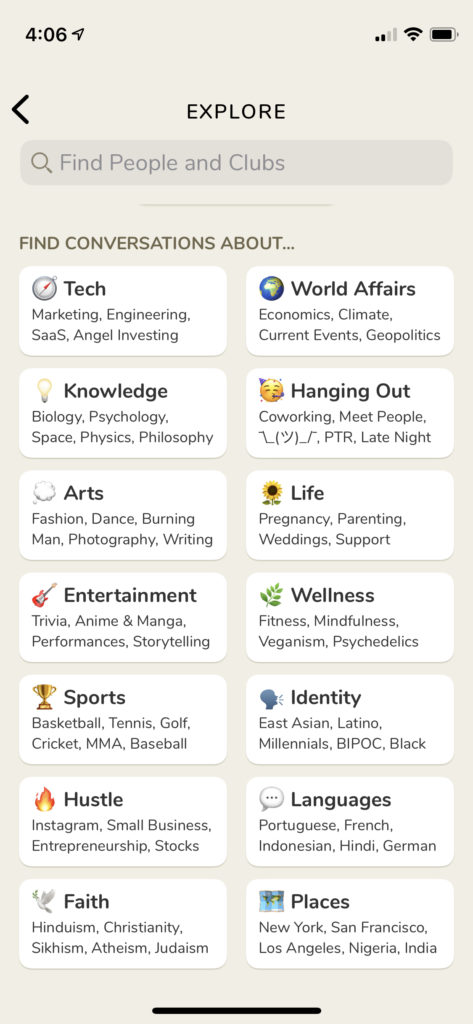 Touch a category to go deeper. For example, the “Arts” category includes topics like “Burning Man,” “Photography,” and Dance. Tap on each of those categories to go even deeper. Just below the topics, you’ll find clubs related to this category that you can follow. Once you do, you’ll receive notifications when someone in the club starts a new room.
Touch a category to go deeper. For example, the “Arts” category includes topics like “Burning Man,” “Photography,” and Dance. Tap on each of those categories to go even deeper. Just below the topics, you’ll find clubs related to this category that you can follow. Once you do, you’ll receive notifications when someone in the club starts a new room.
There’s an even easier way to follow a club once you’re in a room or the hallway. Simply click on the little monopoly-look-alike green house next to the name of the club. That will take you to the club page.
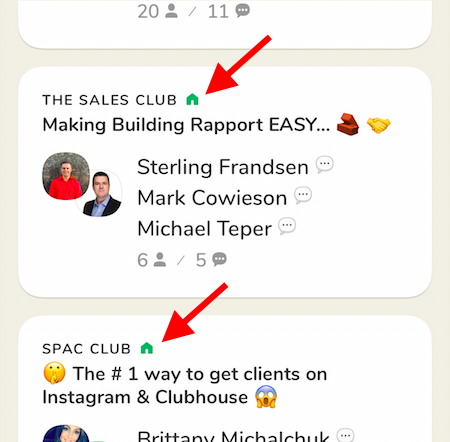 This is the club page for The Copywriter Club:
This is the club page for The Copywriter Club:
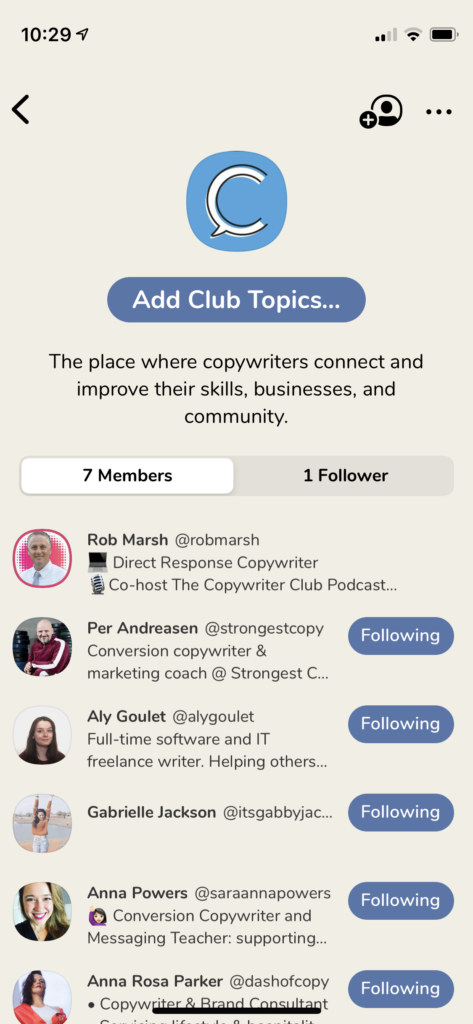
Want to follow what happens there? Click the follow button. You can also see a list of the club members (who you may also want to follow).
The list of interests and rooms is almost endless, everything from song writing, technology and sports to marketing, dating and entrepreneurship. There are dozens of rooms on topics like “what it takes to run a $1 million business.” We’ve recently been in rooms discussing all the proof for the existence of aliens (yes, seriously), book writing, stand-up comedy, and the future of US and China relations. If you can think it, there’s probably someone talking about it on Clubhouse.
Tips for optimizing your Clubhouse experience.
While all the action on Clubhouse is currently in the rooms, everything really starts with your bio. This is where people can learn more about you, your business, and the problems you solve. Consider using emojis to draw attention to different parts of your bio. Here’s what Kira Hug’s bio page looks like:
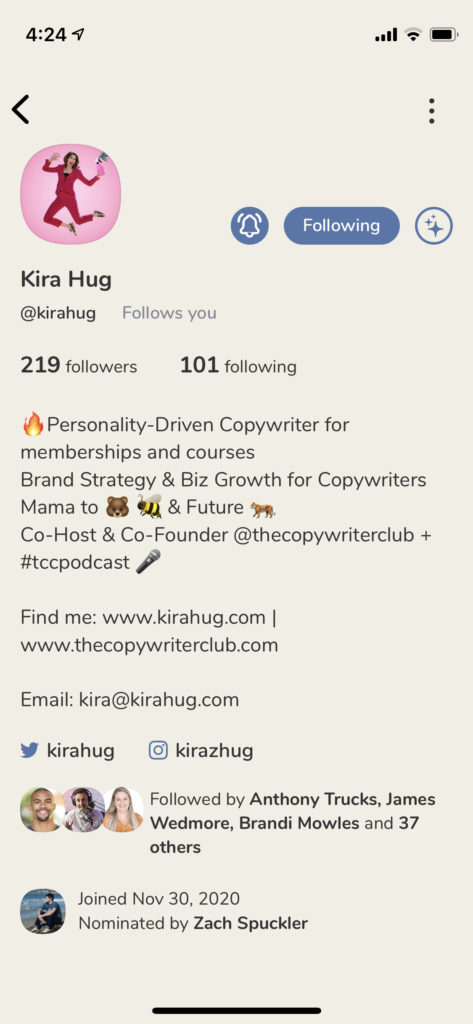 The most important part of your bio is the first two lines. This is what shows up first when someone clicks on your photo icon. And Clubhouse experts suggest that these two lines are also the most important when it comes to what the algorithm searches. So make sure to include the keywords people will use to look for you—your title (copywriter, consultant, brand strategist), your niche (if you have one), and the problem you solve for your clients (we like to call this combination your X-Factor).
The most important part of your bio is the first two lines. This is what shows up first when someone clicks on your photo icon. And Clubhouse experts suggest that these two lines are also the most important when it comes to what the algorithm searches. So make sure to include the keywords people will use to look for you—your title (copywriter, consultant, brand strategist), your niche (if you have one), and the problem you solve for your clients (we like to call this combination your X-Factor).
If you’ve got questions about the best way to share your X-Factor, check out the X-Factor Manifesto training (and the X-Factor Special Report) available in The Copywriter Underground.
After you’ve added a few personal details to your bio, the next step is to connect your bio to your social media accounts. Currently you can add both Twitter and Instagram accounts. Clubhouse doesn’t currently allow direct messaging within the app, so users generally jump to one of these apps to DM people they want to connect with. If you don’t link your social media accounts, you can’t do that. And you’ll miss the opportunity to connect with other Clubhouse users.
Note: be careful promoting Clubhouse on Instagram. We’ve recently heard (though not confirmed) that Instagram is suppressing comments and posts that mention Clubhouse. If you talk about Clubhouse on Instagram, pay attention to your engagement to ensure you’re not hurting your reach there.
One other thing you may want to consider is adding a URL to your bio where you can send people for a lead magnet or some other bonus. Depending who you connect with on the app, this could be the first step in a funnel that leads prospects to your copywriting website.
Browsing the hallway in Clubhouse.
When you log into Clubhouse, you start out in the main feed which users call the “hallway.” This is a list of rooms you can join—usually there is a title at the top of each one with details about the discussion topic. Simply scroll to see more rooms…
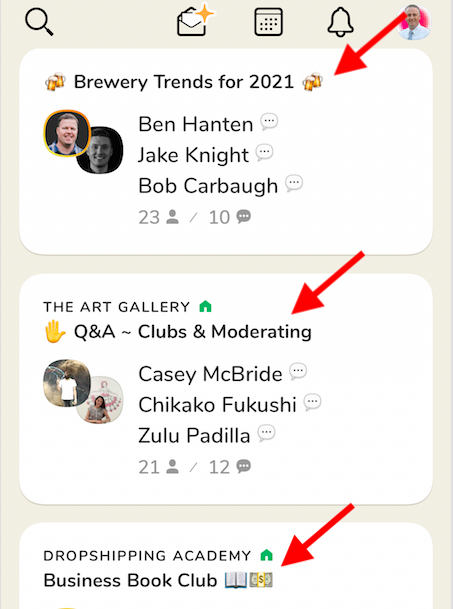
While you’re in the hallway, you’ll also see a list of names of some of the people in the rooms. If you’re following someone in the room, their name will show up here (along with others you don’t follow). Simply tap on the room and you’ll join the discussion already underway.
Leaving is easy… just click the leave quietly button.
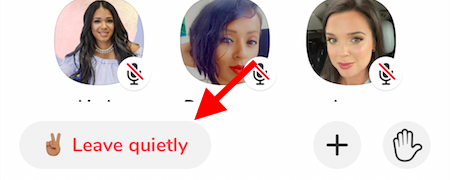
You can also tap the “All Rooms” button at the top to go back into the hallway (while you continue to listen to the discussion in the room) and browse other rooms.
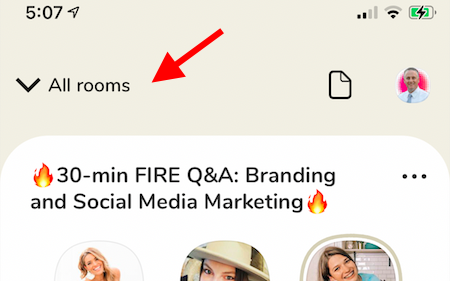
If you tap to join a different room, you’ll automatically leave the one you are in to join the new room.
Don’t worry about saying goodbye or excusing yourself (unless you started the room), the Clubhouse culture encourages users to come and go as they please.
The average room lasts about 90 minutes, though some rooms last for hours… and a few people have attempted to set the record for the longest room… running discussions that last for 4-5 days or more.
If you see rooms that you have no interest in joining… maybe the topic doesn’t appeal to you, hold your finger down on the room until the “Hide This Room” option appears. Click it and the room will disappear from your hallway.
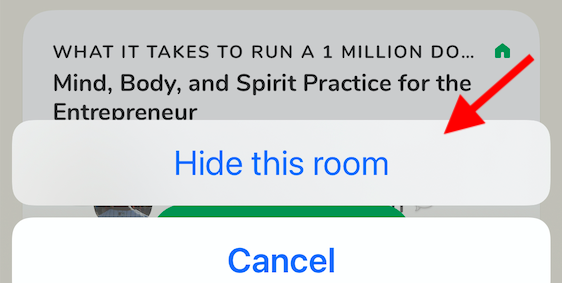
Clubhouse experts report the app developers are considering different hallways based on interests and topics… something that will probably have to happen as the number of rooms grows and becomes unmanageable.
How to start a room on Clubhouse.
Like everything else on Clubhouse, this is easy. Simply click the green “Start a room” button when you are in the hallway.
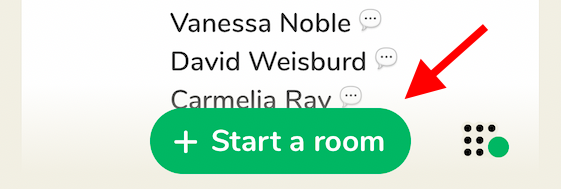
Choose a catchy but non-spammy name for your room. Once your room is open, you can click the “+” button to invite your contacts to join you.
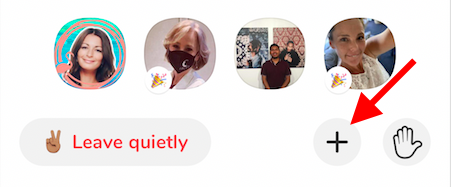
And your room will appear in the hallway of your contacts so they can join there too.
To schedule a room in the future, click the calendar button, then the calendar+ button in the upper right corner. Add a name for your room, called an event here. Then add a co-host if you have one (Rob Marsh and Kira Hug co-host Copywriter Club rooms together). Then choose a date and time (the time will automatically be your local time). Finally you can select a host club if you want, however this isn’t necessary. Touch this option and you’ll see the clubs you belong to and select the most appropriate choice.
To share the link, simply click the calendar button, then touch the “UPCOMING FOR YOU⬇” link at the top of the page. Then click “My Events” to see any future events you have scheduled. Clicking on the event will bring up a screen with several sharing options including tweeting the link, or sharing by AirDrop, email, messages, as well as a few other options.
Each room is organized into three areas. At the top is the stage where the moderators and speakers appear. Just below them is what some users are calling the front row. This is made up of people that the speakers follow (and its usually more than one row). Finally is the audience where you’ll show up unless someone on stage follows you.
As the room owner, you are automatically a moderator which allows you to mute people, flag trolls, and invite other people to the stage. You can also make others moderators. But make sure you trust anyone you make a mod… moderators can block you from your own room. Only add moderators you trust.
How to start your own club.
In March 2020, Clubhouse added the option for anyone to start their own club. The result has been a proliferation of clubs with different interests. To start your own club, go to your profile and scroll down the the bottom where you’ll see the icons for the clubs you belong to. At the far right is a gray circle with a +.

Touch that button and you’ll get a page like this where you can add the name of your club, add a photo or icon, invite members and adjust a few settings like allowing members to start their own rooms under your club or making your member list private.
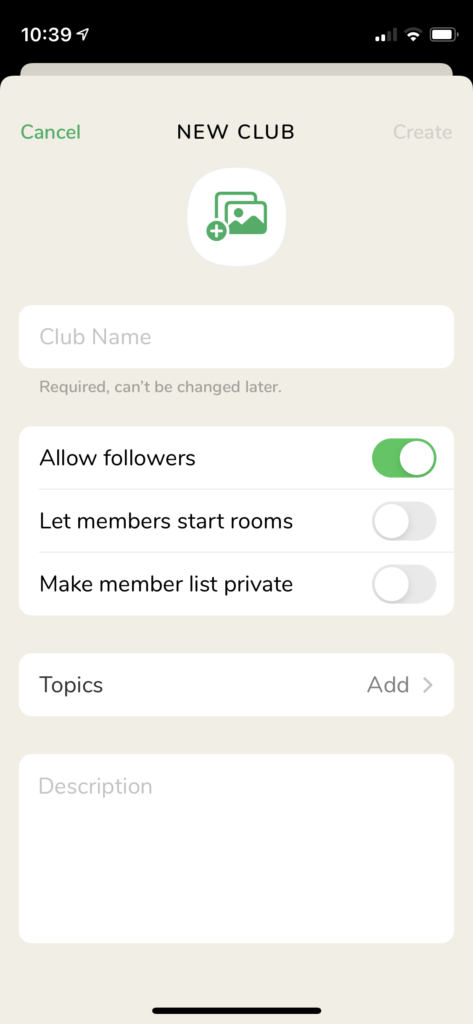
Add a description, then tap the “create” button at the top of the page and your club will go live. Invitations will also go out to anyone you’ve invited to join. You are currently limited to ownership of two clubs.
How to get on a Clubhouse “stage”.
The easiest way to get on stage is to start your own room in your own club (see the two previous sections). That makes you the host and gives you control over who you invite up to speak and who can be a moderator. To do that, simply hit the green “Start a room” button at the bottom of your screen when you’re in the hallway.
When you join someone else’s room, they have to invite you onto the stage before you can join the conversation. To let them know you have something to say or a question to ask, click the hand icon at the bottom right of your screen.
Once a moderator sees that you have something to say, they’ll bring you onto the stage and let you know when you can speak. Clubhouse doesn’t automatically mute your mic (a serious bug in our opinion), so when you are moved up to the stage, click the microphone button immediately to mute as you wait to speak.
Different rooms have different rules for speakers. Often panelists on stage will comment in order from left to right. In other rooms a moderator will call on you. Be aware of the expectations of the room you’re in before you raise your hand to participate. Don’t talk over the other participants.
If you get your chance on stage, start by saing your name and a one-line version of your X-Factor, then ask your question or share your advice. Be concise. The others in the room will appreciate it.
The owner of the room may also make you a moderator. If that happens, you have the ability to bring people up on stage and send them back to the audience. And you might take part in leading the discussion depending on who else is in the room.
How copywriters are using Clubhouse to find clients.
Copywriter Kathy Young is the sort of person who refused to join Clubhouse because who needs another social media app?. But she jumped in any way and has since grown her instagram account by almost 1,000 followers AND secured several leads with the platform. Now she believes it’s a platform worth investing in.She started on Clubhouse by joining rooms that others in her network were hosting—people she had engaged with on social media. In her first room ever, the moderator invited her to the panel to share her insight. She spoke off-the-cuff trying to share something valuable for the room—and was surprised to have more fun than she expected. Following that success, she joined other small rooms where returning audience members would recognize her. Finally she started her own room with a photographer and design expert.
That experience resulted in a lead in her inbox. Her prospect said they loved the discussion on CH and wanted to learn about working together. She’s also been asked to host rooms with other clients. Now she shows up on Clubhouse regularly to boost her visibility and authority in rooms where her ideal clients hang out.
How copywriters are using Clubhouse for customer research.
The most obvious way to do this is to jump into rooms that match your target audience’s interests. Writing for course creators? You’re in luck. There are dozens of rooms talking about that. Writing for SaaS or wellness or small business or healthcare? Same thing. Lots of rooms full of people asking questions and discussion ideas and problems. Just get into the room and LISTEN.
This is exactly what copywriter and marketing expert, Christina Torres, does. She’s a moderator for a weekly room called “Copy SO good your customers throw 💰 at you,” hosted by Hayley Hobson. It’s a copywriting-focused discussion where anyone can ask questions about copywriting. For copywriters, this is a great place to eavesdrop on your (direct or indirect) competition to see what problems and solutions are affecting your ideal customers.
She recommends that copywriters join rooms where their customers are. Bring a notebook and jot things down—word for word—to get amazing specific voice of customer. Even better, if you can get on stage as a speaker or a moderator, you have the opportunity to test your theories, ask questions, and talk directly to your audience’s problems.
But Christina says the best way to use Clubhouse for research is to host your own rooms. Think about what your audience is coming to Clubhouse to learn or figure out. What are is my customer, cient or community thinking about right now? Start a conversation or club around the problems/topics/offers that speak to that.
You’re not holding a webinar or sales discussion. Rather it’s a real conversation where you get continuous, real-time feedback. You can do it by yourself or put the word out to your network to get more people into the discussion. Again, grab your notebook and write down what people are sharing.
If starting your own room is intimidating, pair up with someone else. Make a list of other Clubhouse members who could add value in the discussion and invite them. Post a comment in The Copywriter Club FB group asking for others to join you. Reach out to a coach, mentor or friend. Just put out a feeler or two and get busy.
There’s even a way to take a Y/N poll once you’re in a room (if you are a moderator or you own the room). Say you have a question that can be answered “yes” or “no.” Turn on the raise your hand feature, then say, “I’m going to open up the raise hand feature. If you agree with [insert your idea or question here], then hit the hand button. If you disagree, keep your hand down.” And CH will tally the number for you.
Finally, you can host an actual private focus group. Simply reach out to a small group of people in your target audience and let them know you value their opinion and would like them to join your focus group. You will need to invite them using their Clubhouse handle in order to keep the discussion private.
Christina suggests using a script like, “Hey, I value your opinion and I’m hosting a focus group—no commute, no pants, no makeup, and no judgement. I really would like to hear your thoughts about [insert your topic]. Come to my clubhouse event…” and then share the date and time. You might even give them an incentive to participate.
In your private group, you can ask open-ended and qualitative questions then see where the conversation goes. Again, take notes so you can use the information later.
How copywriters are using Clubhouse to build authority.
This is an obvious use for Clubhouse as the app is designed to attract an audience and has a built in stage where you can share ideas, processes, tactics—and whatever else comes to mind. Australian copywriter, Kate Toon, has set up her own club, The Misfit Entrepreneur, where she hosts discussions about business, marketing, SEO and copywriting.
Copywriter Brittany McBean recently hosted a room with her OBM Erika Macauley to talk about how her business has grown and the systems she’s put into place that allow her to charge $15-25,000 per project.
And Kira Hug and Rob Marsh (the owners of this very helpful website) have hosted rooms to talk about topics ranging from marketing ethics to finding clients—and they’ve invited members of The Copywriter Club to share their thoughts on those stages.
As these copywriters show up to share their thoughts and ideas with a different audience than they find on Facebook or Instagram or even on their email lists, listeners are able to follow them, get their lead magnets, and start relationships that can have a lasting impact.
If you want to get noticed on Clubhouse, ignore the massive rooms with thousands of people in the audience. In those rooms, the chances of getting invited to the stage (unless you know a moderator) are slim. Instead, join smaller rooms where you can add valuable comments and advice. Small rooms have space for everyone to contribute and will result in more people following you than showing up in large rooms.
The best rooms for copywriters.
Copywriters love to hang out with other copywriters. So it’s no surprise that copywriters have already started creating their own clubs and rooms. The Copywriter Club has its own club and been hosting a weekly room on Tuesdays at 1:00 PM ET. If you’re a copywriter or marketer interested in copywriting, you should check it out.
Copywriter Ray Edwards hosts a group called (somewhat confusingly) The Copywriting Club. Parris Lampropoulos runs a club called Marketing All-Stars. Kate Toon’s Misfit Entrepreneurs group often talks about marketing and copy. There’s an every-Saturday-afternoon room called, “Copy SO good your customers throw 💰 at you” that’s moderated by copywriters and experts like Laura Belgray, Brandi Mowles and Christina Torres. There are groups for FB Marketing Secrets, Entrepreneurship, Freelancing, and more. Use the search feature (set on “clubs”) to find the ones that interest you.
Other stuff we like about Clubhouse.
Unlike Facebook, Instagram, or Twitter, there is no social media manager or intern posting or speaking for you or anyone else on the platform. You can’t “photoshop” your voice (yet). And while there are almost certainly fake accounts, when Malcolm Gladwell or Drake or Elon Musk or Oprah show up on the app, you get to listen to the real person. Not their PR handler.
Second, it’s interactive, unlike podcasts. Podcasters might say things like, “join the conversation,” but let’s be honest, the podcast conversation is pretty much one way. Not so with the best rooms on Clubhouse. There are real, honest, and sometimes heart-felt conversations happening there.
Finally, while we’re sure that ads will find their way onto the platfrom at some point, for the moment, it’s one of the few places in the world that is ad-free (if you don’t count the links in bios and speakers talking about their products). We’ll enjoy that while it lasts.
What are the limitations of Clubhouse?
This will certainly change (and we’ll try to update this article when it does) but Clubhouse doesn’t have any way to message another user. Which means you’ll often hear speakers suggest you jump over to Instagram or Twitter to connect with them. We can’t imagine that Clubhouse’s founders like that, so we won’t be surprised if messaging is added at some point.
Also there is no video (obviously). Which is kind of the point. Not having to get dressed, comb your hair, or turn on a ring light before jumping in makes the interactions a bit more casual and quite frankly, enjoyable.
There is no recording and therefore no replays. In fact, it’s against the Clubhouse rules (though some people skirt the rules). This means almost everything on Clubhouse happens in the moment (it’s been called synchronous audio). You can’t queue up calls to listen to when you have time, like you can with podcasts. If you miss a “room” there is no replay. You’ve got to be there to experience it. Given the legal risk of recording someone who hasn’t explicitly agreed to be recorded, we’d recommend not recording until CH changes the rules. But also, you should assume that everything you say IS being recorded and act accordingly.
The audio-only approach with no recording or transcriptions means that it’s not a great app if you are deaf or hard of hearing. We’re not the first to mention this and our guess is that the app may some day add real-time captioning to address this. Time will tell. However users like Rachelle Dooley aren’t waiting. She runs the club Deafinitely Inclusivity and is working to bridge the gap. Give her a follow: @deafinitelyme.
Rooms don’t have an infinite number of seats. The current limit is 8,000 (we recently tried to join a club with 7,900 attendees and got a notice that it was full), which seems like a lot. In fact, most of us are in no danger of hitting that limit. But when someone like Elon Musk interviews Kanye West, the room fills up in seconds and no one else can get in. Because there is no way to watch a replay, the demand for these live moments is much larger than the capacity.
Content moderation is difficult. While rooms have moderators with the power to elevate speakers and remove them, there are rooms with hate-filled misogynistic, anti-semitic, racist content. Clubhouse has features that allow users to block and report anyone violating the community standards. And given that the CH algorythm shows you rooms based on who you follow, you may never see these offensive rooms. In our experience, the good rooms far outnumber the bad.
Finally, like so many other social apps that allow free speech, Clubhouse is now facing a shutdown by oppressive governments, most notably China.
Is there anything else like Clubhouse?
Not yet. But that won’t last. Remember when SnapChat released stories—a collection of daily snaps to share with your friends? Facebook quickly followed with their own version of the feature, also called Stories. And late to the party, Twitter released their own version of the feature, called Moments.
The big names in social media aren’t about to give up their users to a new app. So it’s no surprise that Facebook is already working on its own audio chat features. Mark Zuckerberg has even joined Clubhouse… maybe to figure out which features Facebook can most easily copy? And Twitter is slowly rolling out its own version of Clubhouse called Spaces.
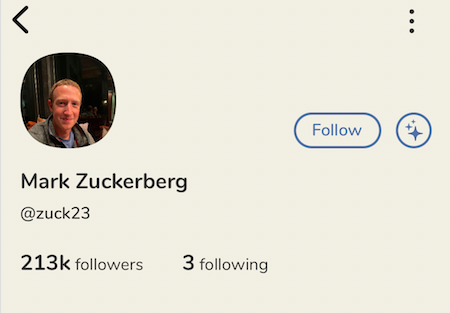
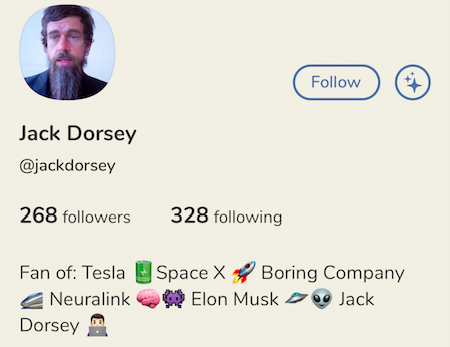
Whether or not these copy cats replace (or acquire) Clubhouse remains to be seen. It’s possible that CH users will choose to stay in their familiar social media apps when they release audio features. Or that Clubhouse will go the way of Meerkat and Vine. But for now, Clubhouse is the place to be when it comes to social audio.
A few Clubhouse resources you might like:
See all the rooms on Clubhouse here. Use the language filter to cut your result down to a few thousand.
Some Club hosts are using Host Notes to keep a record of what happens in their rooms.
Clubhouse’s official new user guide is here. And the knowledge center is here.
And if you want to host your own club, you can apply for the here.
Finally be sure to check out Laura Belgray’s write up about Clubhouse here.
Do you have a CH club or room that copywriters should be in? Do you know other copywriters who are “must-follows” on Clubhouse? Let us know in the comments so we can follow them too.

